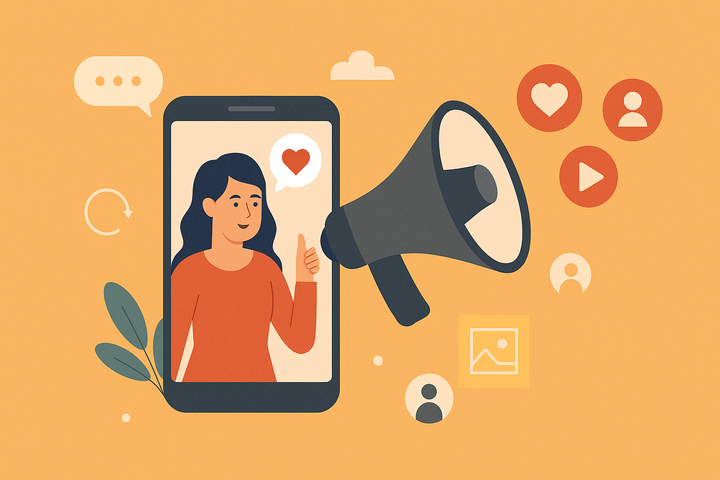What is Influencer Marketing: Everything You Need to Know

We’ve all been there—scrolling through Instagram, TikTok, or YouTube when a favorite creator casually drops a product recommendation that seems… well, too good to ignore. Was it an ad? Was it just a personal favorite? That blurred line between promotion and authenticity is where influencer marketing thrives.
In this guide, we’re diving deep into what influencer marketing really is, why it’s so powerful, how it’s evolved, and what brands and creators alike should know to make the most of it. Whether you’re a business owner, marketer, or a curious creator, by the end of this read, you’ll not only understand the core of influencer marketing but also how it’s shaping the future of advertising.
What is Influencer Marketing?
At its core, influencer marketing is a type of social media marketing that involves endorsements and product placements from individuals who have a dedicated following and are seen as experts within their niche. These individuals—called influencers—have the power to affect the purchasing decisions of others because of their authority, knowledge, or relationship with their audience.
Unlike traditional celebrity endorsements, influencer marketing feels more relatable. You're more likely to trust a skincare product if it’s recommended by someone whose acne journey you’ve followed for months than a famous actress with flawless skin you can’t relate to.
Influencer marketing is effective because it builds on trust. Influencers create communities, not just audiences—and brands benefit from that intimacy.
The Evolution of Influencer Marketing
Influencer marketing isn’t new. In fact, it dates back centuries. Remember when royalty used to endorse certain medicines or perfumes? Or when celebrities featured in TV commercials swore by a particular shampoo? The idea of using someone “admired” to sell something is ancient.
But the modern influencer era began with the rise of social media. Platforms like YouTube gave birth to beauty vloggers, Instagram created travel bloggers, and TikTok... well, TikTok gave everyone a chance to go viral. Suddenly, people with authentic voices—not just polished celebrities—were influencing millions.
Brands quickly realized that working with these individuals could lead to better engagement, increased trust, and ultimately, more sales.
Why Influencer Marketing Works
Influencer marketing taps into the psychology of social proof—the idea that people copy the actions of others in an attempt to reflect correct behavior. If someone you trust recommends a product, you’re more likely to try it.
Here’s why influencer marketing is so impactful:
1. Authenticity and Relatability
Most influencers share real-life experiences, behind-the-scenes content, and honest reviews. Their lives aren’t scripted like commercials; that’s why their followers listen.
2. Niche Targeting
Influencers come in all sizes—nano, micro, macro, and mega. A mom influencer with 10,000 loyal followers might drive better results for a baby product than a global celebrity.
3. Engagement over Reach
An engaged community beats a large but passive one. Influencer marketing allows brands to connect meaningfully through comments, shares, and real interactions.
Types of Influencers
There’s no one-size-fits-all. Depending on your brand and goals, you can work with:
- Nano influencers (1K–10K followers): High engagement, community-driven.
- Micro influencers (10K–100K followers): Ideal for niche audiences.
- Macro influencers (100K–1M followers): Bigger reach, balanced engagement.
- Mega influencers (1M+ followers): Celebrities, large campaigns.
Each type offers different benefits and trade-offs. For newer brands, nano and micro influencers often deliver better ROI due to their genuine connection with followers.
Real Benefits of Influencer Marketing
According to a Sprout Social report, 89% of marketers say ROI from influencer marketing is comparable to or better than other channels. Why?
- Increased brand awareness
- Improved trust and credibility
- Cost-effective campaigns
- Higher conversion rates
- Stronger brand advocacy
Brands no longer have to gamble on whether ads will work—they can use influencer content as feedback loops to learn what resonates and what doesn't.
How Brands Use Influencer Marketing
Here’s how influencer marketing is typically implemented:
1. Identifying the Right Influencer
This is the most critical step. It’s not about the biggest follower count, but about alignment. Does the influencer align with your values? Do they speak to your target audience?
2. Outreach and Collaboration
Once a match is found, brands reach out to pitch collaboration ideas. Some provide detailed briefs; others allow full creative freedom to keep it authentic.
3. Content Creation
Influencers create posts, reels, videos, or stories that seamlessly integrate the product into their lives. Authenticity is key here—audiences can sniff out a forced promo from miles away.
4. Tracking Performance
Using tools like affiliate links, discount codes, UTM parameters, and engagement metrics, brands measure the success of the campaign.
Common Pitfalls to Avoid
Even the best influencer marketing strategies can go wrong if not done thoughtfully. Here are a few traps to steer clear of:
- Focusing only on follower count
- Ignoring fake followers or bot accounts
- Not giving influencers creative control
- Skipping clear goals and ROI tracking
- One-off collaborations with no relationship building
Influencer marketing isn’t a one-time thing—it works best when there’s a long-term partnership that grows organically.
Real-Life Examples
- Daniel Wellington: They built their brand entirely through influencer partnerships—especially with micro-influencers. Each post featured a watch and a unique promo code, making tracking easy.
- Glossier: Their customer-centric approach turned everyday users into influencers. Their community became their marketing engine.
- Gymshark: They leveraged fitness influencers to launch global campaigns, blending lifestyle with performance content.
What Does the Future Hold?
The influencer marketing industry is set to be worth $21.1 billion in 2023, and it’s not slowing down. With emerging platforms like BeReal and continued growth on TikTok, the shape of influencer content will evolve—but the core idea will remain: authenticity sells.
We’ll likely see:
- Increased demand for transparency (e.g., #ad, #sponsored)
- AI-generated influencer content (but still needing human approval)
- More use of performance-based pay models (like affiliate marketing)
- Growth in B2B influencer marketing
Final Thoughts
So, what is influencer marketing? It’s a modern-day word-of-mouth powerhouse—human, authentic, and community-driven. It’s where advertising meets storytelling, and where brands partner with creators to reach people not just through screens, but through trust.
In a world overflowing with content, influencers are the filter. They help people discover, decide, and dive into new experiences. And as long as trust remains a currency, influencer marketing will remain one of the most effective strategies out there.

